Are you looking to make your living space more comfortable and stylish? The secret lies in the art of arranging your sofa and seating. Whether it’s cozy corners or big spaces for parties, where you place your furniture matters a lot. It can turn your living room into a place that truly shows who you are and what you need.
In this guide, we’ll dive into the key principles of living room layout. We’ll show you how to make your space flow well, work well, and look good. You’ll learn how to make eye-catching spots, use every inch of your room, and balance everything for a cozy and inviting space.
Key Takeaways
- Understand the fundamentals of living room layout and design
- Learn how to create focal points and enhance flow in your living space
- Discover strategies for maximizing small and large living rooms
- Explore the art of symmetrical and asymmetrical furniture arrangements
- Gain insights into lighting, area rugs, and accessory placement
Understanding the Basics of Living Room Layout
Designing a living room starts with furniture arrangement. The sofa, the largest piece, should face the room’s center. This could be a fireplace, window, or TV.
Flow and Functionality Principles
For a smooth layout, think about movement and access. Make sure there’s enough room to walk without getting stuck. Each seating area should have a surface for drinks or snacks.
Scale and Proportion Guidelines
Choosing furniture that fits the room is key. The average living room is 13’x18′, and a 9’x12′ rug is perfect for it. Make sure all furniture is in proportion to the room for a balanced look.
Traffic Pattern Considerations
Think about how people will move in your living room. Place furniture to allow easy movement. Formal seating can look great, and big rooms can fit 6-8 people comfortably.
By following these layout principles, you can make a room that looks good and works well. It will be a place you and your guests will love.
Essential Principles of Sofa and Seating Arrangements
Placing furniture well is key to a cozy and nice-looking living area. Don’t push all furniture against walls, which can make small rooms feel cramped. Instead, move pieces towards the room’s center to make it feel open and welcoming.
Area rugs can tie together different seating areas in big rooms. They help create clear zones for talking or relaxing. Also, think about what the room is for. For watching TV, place the sofa and chairs so everyone has a good view. For talking, arrange seats in circles or U-shapes to encourage conversation.

Experts say the TV should be three times the screen size away from seats. For a 40-inch screen, that’s 120 inches. Chairs should be no more than 8 feet apart for easy talking.
| Furniture Arrangement Guidelines | Recommended Measurements |
|---|---|
| Minimum width for minor traffic routes | 24 inches |
| Minimum width for major traffic routes | 30 to 48 inches |
| Minimum clearance between table edge and nearest wall/furniture in a dining room | 48 inches |
| Minimum clearance between bed and wall in a bedroom | 24 inches |
| Minimum clearance between bed and swinging door in a bedroom | 36 inches |
Following these couch placement, comfortable seating, and furniture layouts tips can make your living space both beautiful and useful.
Creating Focal Points in Your Living Space
Designing a visually captivating living room starts with establishing focal points. These points draw the eye and create a harmonious flow. Whether it’s a cozy fireplace, a stunning window, or an entertainment hub, strategically placing your furniture can highlight the room’s most alluring features. This creates a warm, inviting atmosphere.
Fireplace-Centered Layouts
For living rooms with a fireplace, arranging the seating around it can create a cozy, intimate gathering space. About 29% of the highlighted focal point instances in our research used furniture groupings to accentuate the fireplace. This ensures it remains the star of the show.
TV and Entertainment Areas
When the television is the focal point, place the main seating arrangement to face it directly. Also, allow for conversation areas. In 21% of the living room designs we examined, architectural details like mirrors and feature walls were used. They balanced the prominence of the TV and created a more visually balanced space.
Window-Focused Arrangements
Large windows can serve as breathtaking focal points, when paired with strategic furniture placement. Our research showed that 29% of the showcased focal point examples involved arranging furniture to highlight the room’s natural lighting and views. This creates a sense of openness and tranquility.
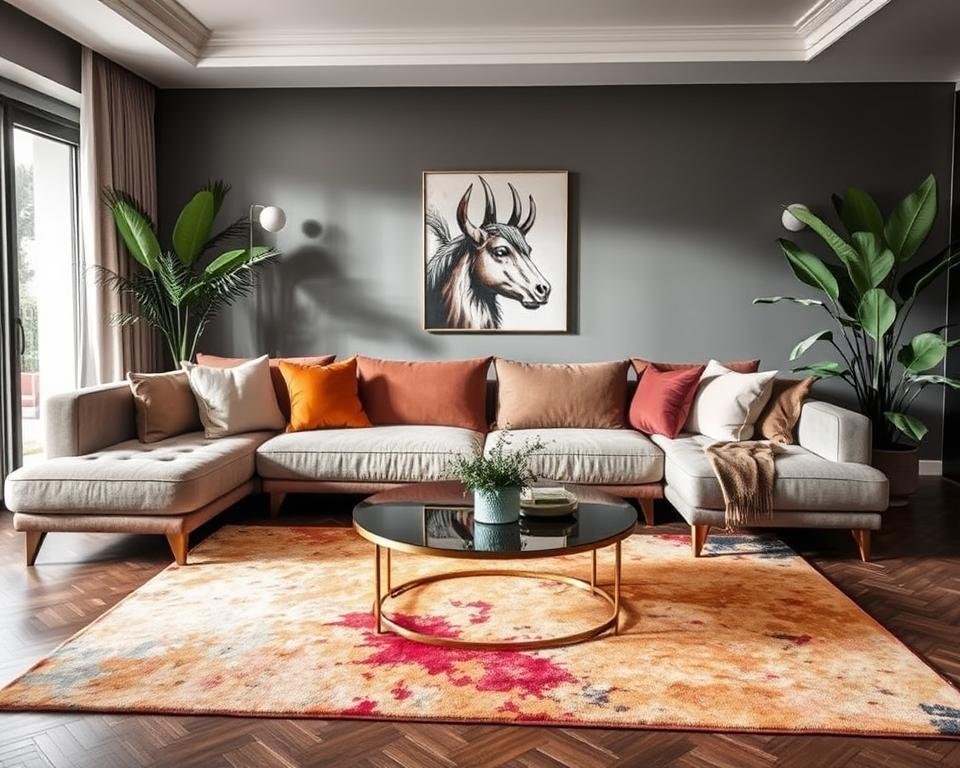
Whether your living room features a fireplace, a TV, or stunning windows, understanding how to leverage these architectural elements as focal points can transform your space. By thoughtfully arranging your furniture and incorporating complementary design elements, you can create a living room that is both functional and aesthetically pleasing.
Small Living Room Layout Solutions
Designing a small living room layout is a big challenge. But, with smart strategies, you can make it cozy and functional. Let’s look at some clever ways to make your small living room feel bigger.
Choosing the right furniture is key. Go for chairs instead of a big sofa to save space. Placing your seats diagonally can also make a small room feel more lively.
Light and easy-to-move furniture is perfect for small spaces. You can change your couch placement and other pieces easily. This lets you adjust your interior design as you like.
Creating a Focal Point
Having a clear focal point is important in small rooms. Place your furniture around a key feature, like a fireplace or big window. This makes the room look balanced and more interesting.
| Layout Tip | Percentage of Usage |
|---|---|
| Furniture placement around a central focal point | 60% |
| Avoiding furniture against outer walls | 40% |
| Using light-colored furniture with legs | 33% |
| Incorporating a neutral color palette | 33% |
| Utilizing multi-functional furniture | 20% |
| Incorporating practical storage solutions | 20% |
By carefully arranging your couch placement and other items, you can turn a small living room into a cozy spot. With some creativity and good space planning, your small room can become a peaceful haven in your home.
“In small living room design, it is recommended to create a central gathering area as well as at least one intimate area.” – Suzanne Dawson, Interior Design Consultant
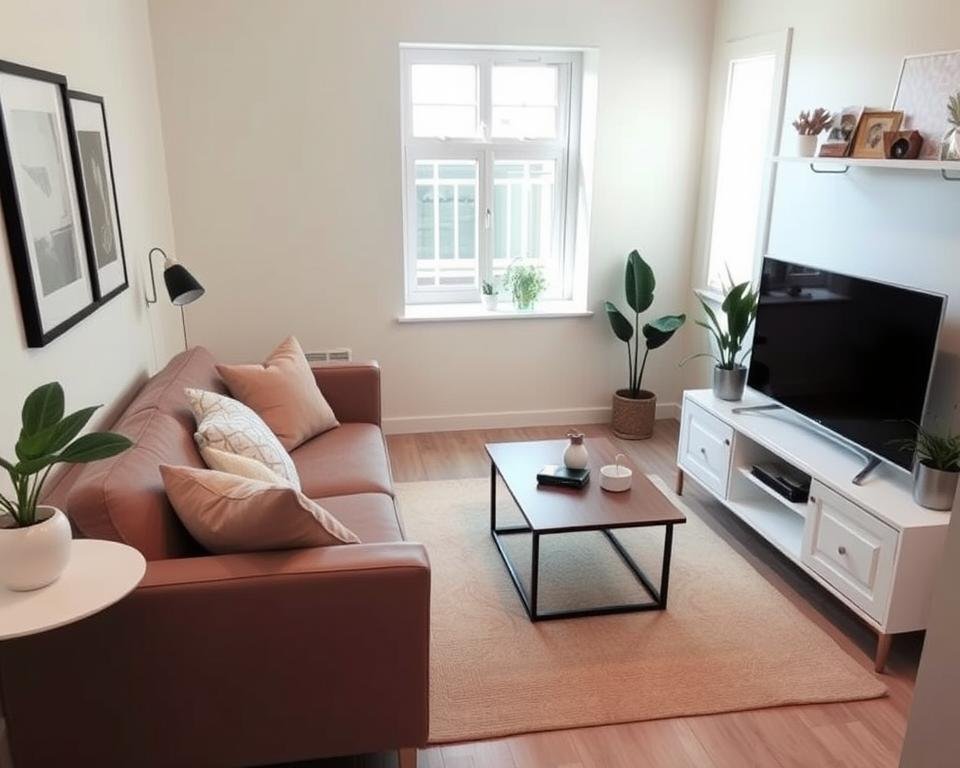
Maximizing Space in Large Living Rooms
Large living rooms need smart planning to feel cozy and useful. Divide the space into different areas for sitting and activities. This way, you make the most of the room for talking or watching movies.
Multiple Seating Zones
Think of your living room as a place where you can set up different spots. Use a mix of living room furniture like sofas and armchairs to make clear zones. This makes the room look good and feel right for your needs.
Conversation Areas
Make a cozy spot for talking in your big living room. Place two sofas or armchairs around a coffee table. It helps everyone feel close and talk more.
Entertainment Spaces
Set up a special area for watching TV or playing games. Arrange the seats so everyone can see and enjoy together. Use big sofas or a mix of chairs and sofas for big groups.
Getting the most out of a big living room is all about balance. By dividing it into different sitting areas, you make a space that’s both beautiful and useful for all your activities.
Symmetrical vs. Asymmetrical Arrangements
In interior design, choosing between symmetrical and asymmetrical layouts matters a lot. Symmetry brings a sense of order and balance, fitting well with formal designs. It makes a space feel stable and harmonious.
Asymmetry, on the other hand, brings a relaxed and dynamic feel. It adds interest and prevents a space from feeling too stiff.
Many famous buildings show off different symmetries. For example, the Taj Mahal has bilateral symmetry. The Basilica di Santo Spirito in Florence uses rotational and reflection symmetry. In furniture layouts and home decor, symmetry can make modern and minimalist spaces look better when done right.
Asymmetrical setups, like the Farnborough Airport Terminal Building and the Queen Sofia Palace of the Arts, bring a sense of movement. They make rooms feel more casual and welcoming. The Starry Night painting by Vincent van Gogh is a great example of asymmetrical design.
Finding the right mix of symmetry and asymmetry is key to a beautiful living space. Designers use central points, mix symmetrical and asymmetrical elements, and focus on scale and proportion. This way, they create furniture layouts that fit their clients’ needs and tastes.
“Symmetry is associated with order, stability, and balance, while asymmetry can introduce movement, spontaneity, and dynamism. The art of interior design lies in striking the perfect balance between the two.”
Whether you choose symmetry or asymmetry, the goal is to achieve harmony and balance. This makes your interior design scheme visually appealing and functional for those who use the space.
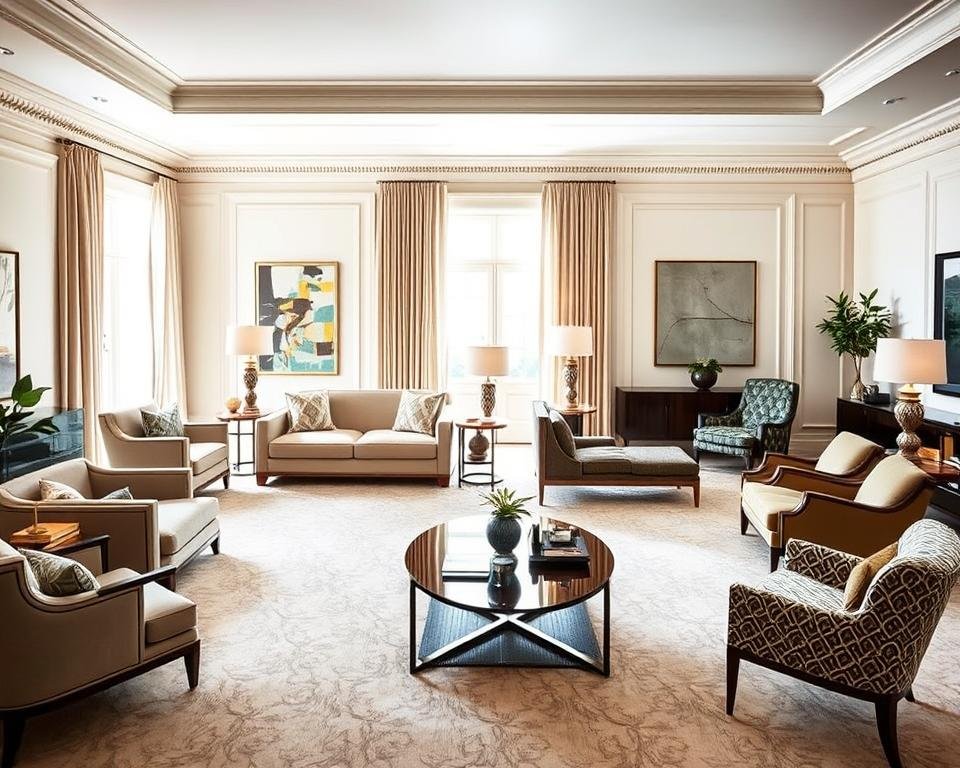
The Art of Furniture Placement for Conversation
Setting up your living room for conversation is like a work of art. By placing furniture so it faces each other, you make a cozy spot for talking. It’s all about finding the right mix of comfort and connection, so everyone feels welcome and can chat easily.
Social Distance Optimization
In big living rooms, think about how close you want people to be. Pulling furniture together makes the space feel more personal. Use coffee tables to anchor conversation areas and keep drinks within easy reach, making the atmosphere relaxed and welcoming.
Creating Intimate Settings
To make a cozy spot for talking, arrange furniture wisely. In big rooms, use sofas, chairs, and tables to create different areas. This makes the room feel snug and encourages people to chat.
U-shaped layouts are great for small rooms. They use space well, making a comfy spot for talking without taking up too much room.
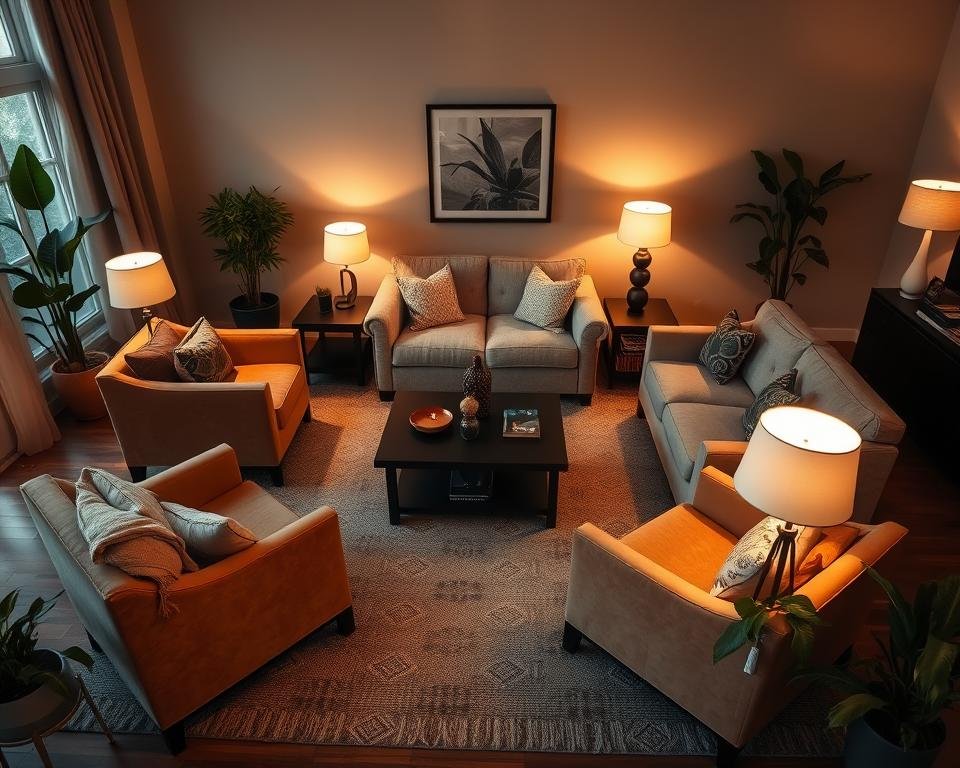
“The most-used furniture combination for conversation-oriented spaces involves a sofa and two chairs.”
By thinking about where to put your furniture, you can make a space that invites conversation. This way, you create a place where people can connect and make lasting memories.
Open-Concept Living Room Arrangements
Creating an open-concept living space needs careful planning. It involves space planning, interior design, and home decor. The main challenge is to make different activity zones while keeping the look cohesive.
Furniture placement is key. Placing sofas or sectionals can divide the living area from dining or kitchen spaces. This creates a clear separation without blocking the flow. It’s important to match design elements like colors and textures across zones for a unified look.
Area rugs are also useful. They can mark off different areas in the open space. This helps guide the eye and subtly defines spaces for various activities. By arranging furniture and using area rugs, you can make an open-concept living room that looks good and works well.
“The key to successful open-concept living room design is to define distinct zones without compromising the overall flow and visual harmony of the space.”
Studies show that in 20 open-concept living rooms, 4 used a sofa to divide space. Two rooms had two sofas facing each other. Also, 2 spaces left an open hallway without furniture to improve movement between the living room and kitchen.
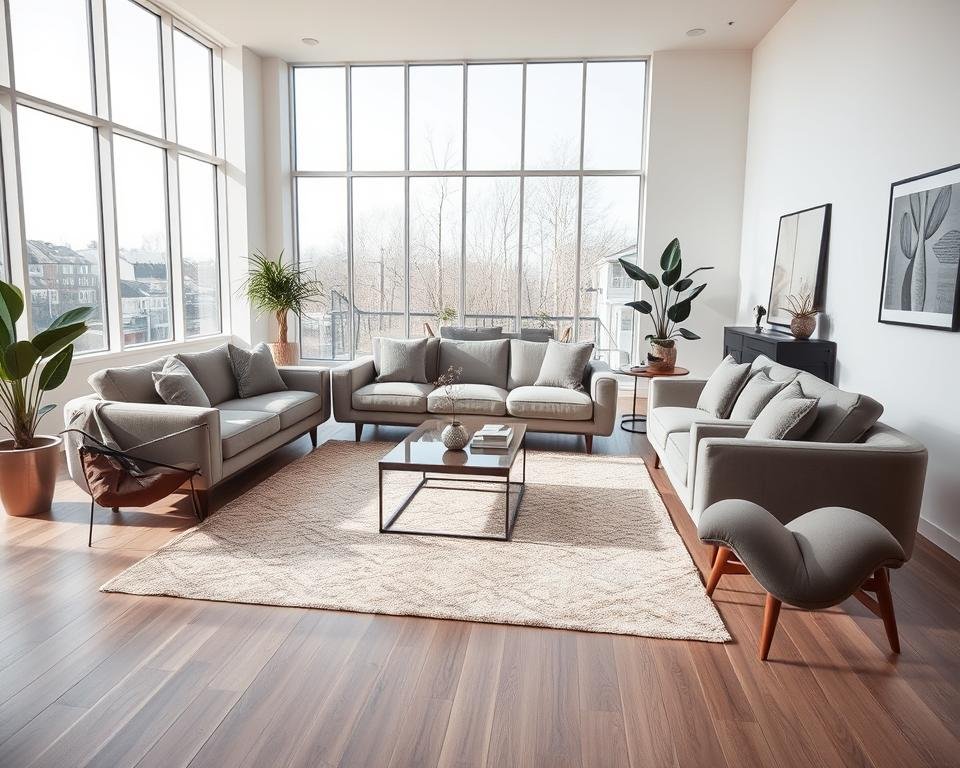
Thinking carefully about furniture placement and using area rugs are key. A harmonious design approach is also vital. These steps help create open-concept living rooms that are both functional and beautiful.
Working with L-Shaped and U-Shaped Layouts
L-shaped and U-shaped layouts are great for making your living room cozy and functional. They help use corner spaces well, offer lots of seating, and create different areas in your room.
Corner Optimization Techniques
Using your furniture smartly can turn corners into cozy spots for reading. Try placing a sectional sofa away from walls to make the room feel more welcoming. Add accent chairs or poufs in corners for more seating and to balance the room.
Sectional Sofa Placements
Sectional sofas are perfect for L-shaped and U-shaped rooms because they’re flexible and define the space. You can place a sectional against walls to highlight the room’s shape or in the middle for different conversation spots. Try out different L-shape or U-shape setups to see what works best for you.
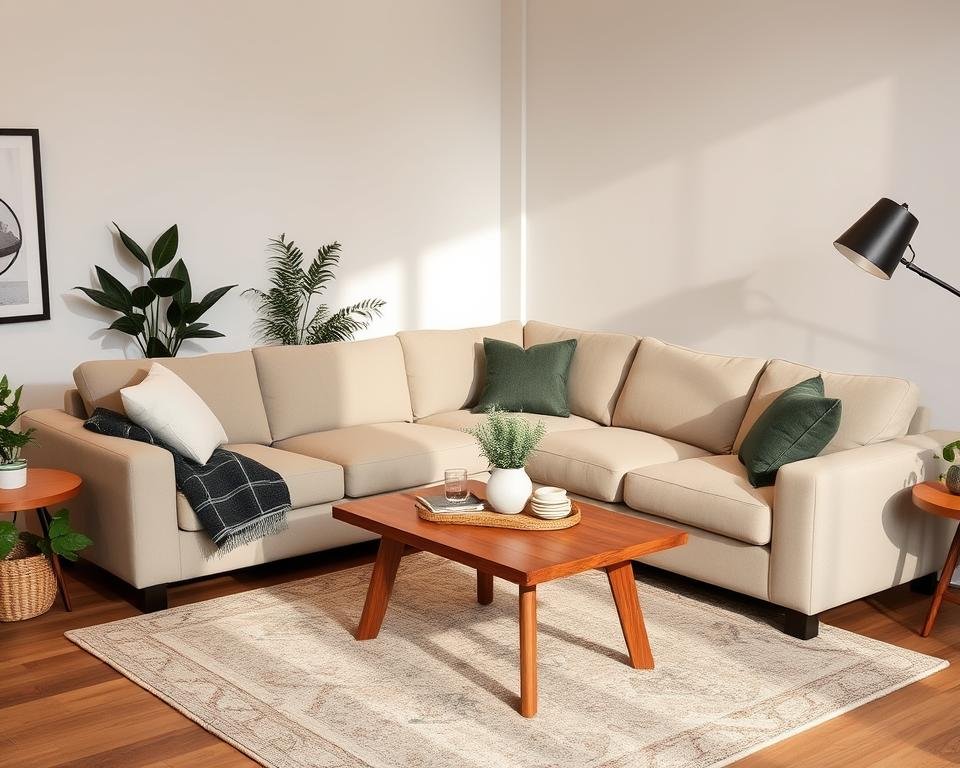
The secret to great L-shaped and U-shaped layouts is finding a balance between looks and function. By placing furniture wisely and using corners well, you can make a room that looks good and works well for you.
Incorporating Accent Furniture and Tables
When designing a living room, the sofa and main seating pieces often take center stage. But, adding accent furniture and tables can make the space look and feel better. These pieces add interest and solve problems like storage, lighting, and extra surface space.
When picking accent furniture, make sure each seating area has a surface for drinks, books, or decorations. Use side tables and coffee tables to meet this need. Also, think about ottomans that can serve as both seats and tables.
- Add accent chairs to make cozy spots or extra seats.
- Pick unique side tables and end tables to bring personality to the room.
- Use storage furniture, like cabinets and bookcases, to keep the room tidy and organized.
| Furniture Piece | Percentage of Layouts Incorporating It |
|---|---|
| Accent Chairs | 70% |
| Mixed Materials (fabrics, finishes) | 60% |
| Varying Table Shapes | 45% |
| Matching Sofas and Accent Chairs | 50% |
| Low-Profile Accent Chairs | 30% |
| Leather Accent Chairs | 40% |
| Matching Accent Chairs | 20% |
| Bench Seating | 10% |
| Varying Accent Tables | 30% |
By choosing and arranging accent furniture and tables wisely, you can make a living room that looks great and works well. It will meet your home decor and interior design needs.

Area Rug Placement and Sizing Guidelines
Area rugs can greatly change how your home looks and feels. They can make a cozy living room, a formal dining area, or a peaceful bedroom look better. Knowing how to place and size rugs is key to a nice-looking home.
Rug Size Selection
The right size rug depends on your room and furniture. A good rule is to make the rug big enough to fit all main furniture pieces. Leave 6 to 8 inches of extra space on each side for a balanced look.
In a living room, a 9×12 or 8×10 rug works well. For a dining room, choose a rug that’s 2 to 3 feet bigger than your table. And for a bedroom, a 9×12 or 8×10 rug fits a king-sized bed, while a full or queen bed needs an 8×10 or 6×9 rug.
Furniture Positioning on Rugs
Where you put your furniture on the rug matters a lot. Try to put the front legs of big pieces like sofas and chairs on the rug. This makes everything look connected and balanced.
In big living rooms, rugs can help create different seating areas. Place furniture in groups. Also, aligning the rug with features like fireplaces or focal walls can make your space look better.
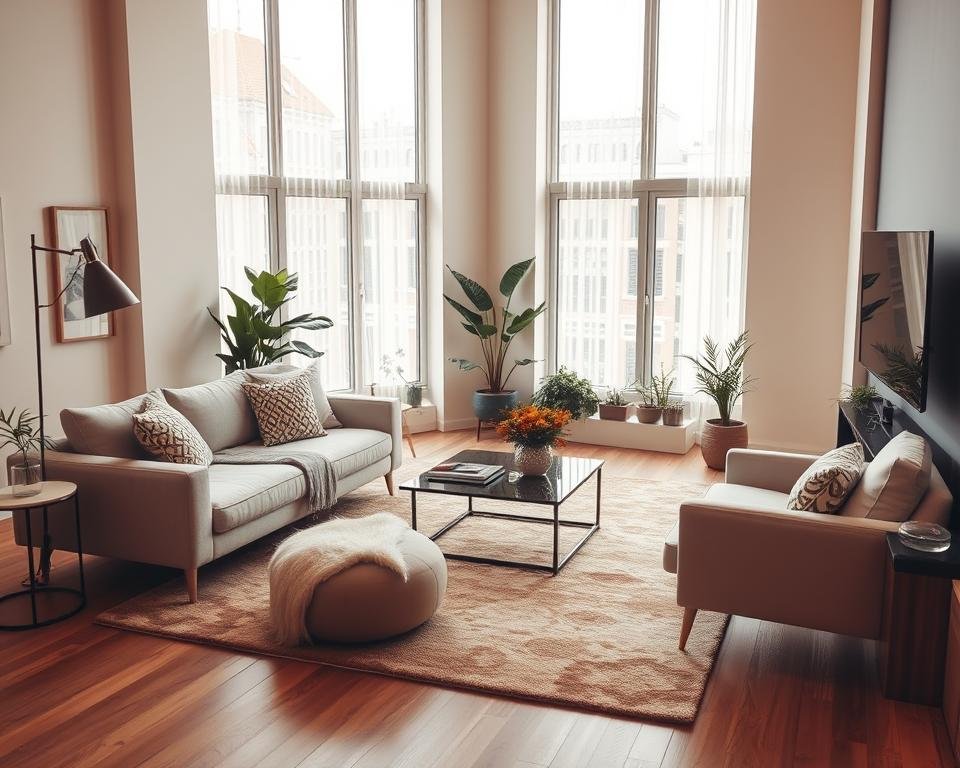
Choosing the right rug size and placement is important for a nice home look. By following these tips, you can make your home look better and feel more welcoming.
Lighting Considerations for Seating Areas
Creating a well-lit living space is key for interior design. A layered lighting approach is essential. This mix of ambient, task, and accent lighting can change your living room’s feel and function.
Ambient lighting, like ceiling lights or floor lamps, sets the room’s mood. It makes the space feel warm and inviting. Task lighting, such as table lamps or wall sconces, helps with activities like reading or working. It improves visibility. Accent lighting, on the other hand, highlights special features or artwork, adding depth and interest.
Think about where to place your lights to match your furniture and highlight key areas. Dimmable lights, like LED strips or adjustable floor lamps, are great. They let you change the light’s brightness for different times and moods.
The color of your lights matters too. Soft white bulbs (2700K-3000K) create a cozy glow. Cool white bulbs (4000K-6500K) are brighter and more energizing. Pick a color that fits your room’s mood and purpose.
With the right lighting plan, your living room will look amazing and be super comfy. It will meet all your seating needs.
| Lighting Type | Purpose | Examples |
|---|---|---|
| Ambient Lighting | Provides overall illumination | Recessed ceiling lights, floor lamps |
| Task Lighting | Focuses on specific activities | Table lamps, wall sconces |
| Accent Lighting | Highlights architectural features or decor | LED strip lighting, decorative wall fixtures |
By using these lighting tips and thinking about color and dimmability, you can make a living room that looks great and works well. It will meet all your design needs.
Flexible Seating Solutions for Entertainment
Creating a cozy and versatile living room is key for fun gatherings. Flexible seating is essential for different activities, like movie nights or chats. Modular furniture and occasional seating can turn your living room into a dynamic space for entertainment.
Modular Furniture Options
Invest in modular furniture, like sectional sofas, for changing needs. Sectionals can be rearranged for different layouts, perfect for various events. Add accent chairs or ottomans for easy movement, creating cozy spots or casual lounging areas.
Occasional Seating Ideas
- Use lightweight, portable chairs or stools for extra guests.
- Try nesting tables or stackable seating for easy storage and more floor space.
- Choose multifunctional furniture, like ottomans with storage, for seating and extra surface.
Flexible seating solutions make your living room a versatile entertainment hub. It’s ready for all sorts of social activities and gatherings.
“The beauty of modular furniture is that it allows you to create a space that adapts to your changing needs, whether you’re hosting a movie night or a lively dinner party.”
| Seating Option | Key Features | Ideal for |
|---|---|---|
| Sectional Sofa | Customizable configuration, versatile arrangement | Adaptable entertainment spaces |
| Nesting Tables | Space-saving, easy storage, multiple surfaces | Flexible additional seating and surfaces |
| Ottomans with Storage | Dual-purpose seating and storage | Multifunctional and clutter-free living rooms |
Balance and Visual Weight in Room Design
Creating balance in your interior design is key to a harmonious space. It makes your room look good and feel welcoming. By spreading out visual weight, you add stability and interest.
The 60-30-10 rule is a good starting point. It suggests using 60% of a main color, 30% of a secondary color, and 10% of an accent color. This rule helps your room look cohesive and striking.
Symmetry is also vital for balance. Placing furniture in a symmetrical way, like two sofas facing each other, adds stability. In dining areas, arranging pieces around a central point works well.
Think about the weight of your furniture and decor. Balancing heavy pieces with lighter ones adds interest. Paying attention to size and pattern repetition makes your room feel designed.
Finding the right balance takes time and practice. Try different layouts and colors to see what works. With patience and a good eye for design, you can make your room a peaceful oasis.
| Design Principle | Description | Example |
|---|---|---|
| 60-30-10 Rule | Distribute colors in a room using 60% primary, 30% complementary, and 10% accent. | 60% neutral walls, 30% wood floors, 10% colorful artwork |
| Symmetrical Arrangements | Create a sense of balance by placing furniture and decor in a symmetrical layout. | Two matching sofas facing each other in the living room |
| Radial Symmetry | Arrange pieces around a central focal point to achieve visual balance. | A round dining table with chairs evenly spaced around it |
“Balance in interior design is something that may take time to achieve. It’s a process of trial and error, requiring patience to let a room settle into its harmonious state.”
– Louise Roe, Interior Designer
Modern Trends in Sofa and Seating Arrangements
In the world of interior design and home decor, trends in living room furniture keep changing. Modern homeowners want multifunctional sofas, bold colors, and eco-friendly options. These trends show a wide range of design directions.
The demand for versatile furniture is growing. The STEALTHO Folding Futon Sofa Couch is a great example. It shows people want furniture that can change to fit their needs. Also, sofas in bold colors are becoming popular, moving away from neutral tones.
Curved sofas are now in style, adding a soft, fluid look to living rooms. They make the space feel welcoming and artistic. At the same time, eco-friendly sofas are becoming more common. This shows a big change towards making furniture in a more ethical way.
- Modular sofas are the top choice in 2024, with a focus on custom comfort.
- Neutral-toned sofas are loved for their timeless look. They are versatile and a good investment.
- Sleek low-profile sofas are popular in minimalist homes. They show a preference for modern design and comfort.
The furniture industry is responding to changing tastes with a wide range of options. This includes using sustainable materials, embracing bold colors, and trying new seating ideas. The interior design world is a place for creativity and innovation.
The home decor industry keeps evolving. It’s clear that the future of living room furniture will be full of different trends. These trends reflect the changing tastes and priorities of modern consumers.
Conclusion
As we wrap up our look at sofa and seating arrangements, it’s clear that careful planning is key. It makes your living room both beautiful and useful. Knowing how to arrange furniture is important. It makes your space look good and work well.
Adding focal points like a fireplace or a great view can make your living room stand out. Also, arranging your seats right can help create cozy spots or make it easy to talk to others.
The secret to great sofa and seating arrangements is to keep trying until you find the right mix. By using the tips from this article and making them your own, you can make a living room that’s not just pretty. It’s also a place where you and your friends can have fun and feel at home.
FAQ
How do I choose the right size sofa for my living room?
Think about the room’s size and how big the sofa should be. Use size guidelines to pick a sofa that fits well. Make sure there’s enough room to move around and for other furniture.
How should I arrange seating to create a comfortable and functional layout?
Make sure there’s a clear path to move around. Each seat should be near a table. Don’t push all furniture against walls in small rooms. Pull pieces towards the center for a more open feel.
What are some tips for arranging furniture in a small living room?
Use chairs instead of sofas to make the room feel bigger. Try diagonal arrangements to add depth. Use light, easy-to-move pieces for flexibility.
How can I maximize seating in a large living room?
Split big rooms into different areas for different activities. Use furniture to create separate spots for talking and watching TV. Sectional sofas or matching pairs can provide lots of seating.
What is the best way to arrange furniture for conversation?
Set up seating so people can easily talk to each other. In big rooms, bring furniture closer for cozy chats. Coffee tables help keep the conversation going.
How can I use area rugs to define different zones in an open-concept space?
Place sofas or sectionals to mark off areas from others. Use area rugs to show where different zones are. Make sure the design looks good together in each zone.
What are some tips for working with L-shaped and U-shaped layouts?
L-shaped and U-shaped layouts are great for corners. Use sectionals along walls to shape the room. Create cozy spots in corners for reading or relaxing.
How do I create balance and visual weight in my living room design?
Spread out the weight of furniture to keep the room balanced. Mix furniture heights for interest. Keep the room open by not overloading it with too much furniture.


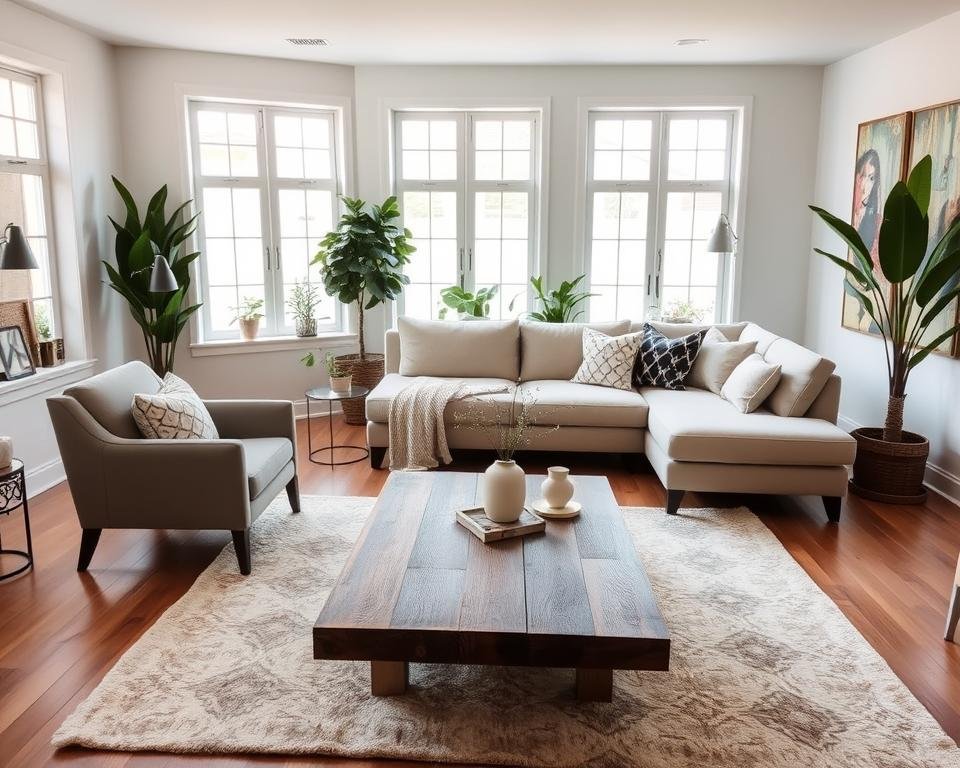
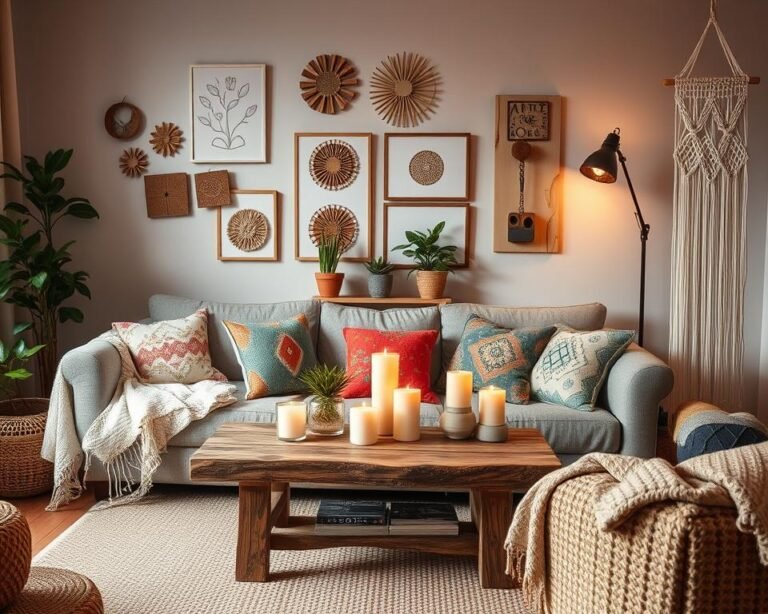
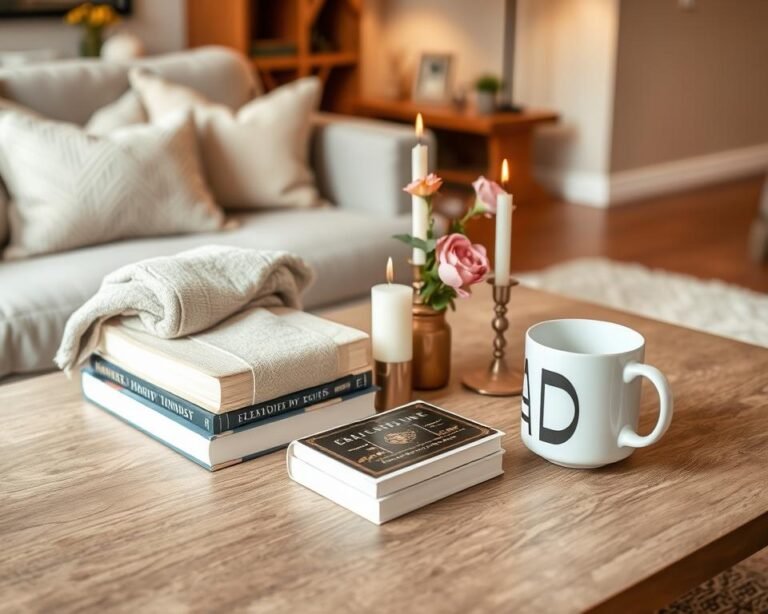
Leave a Comment